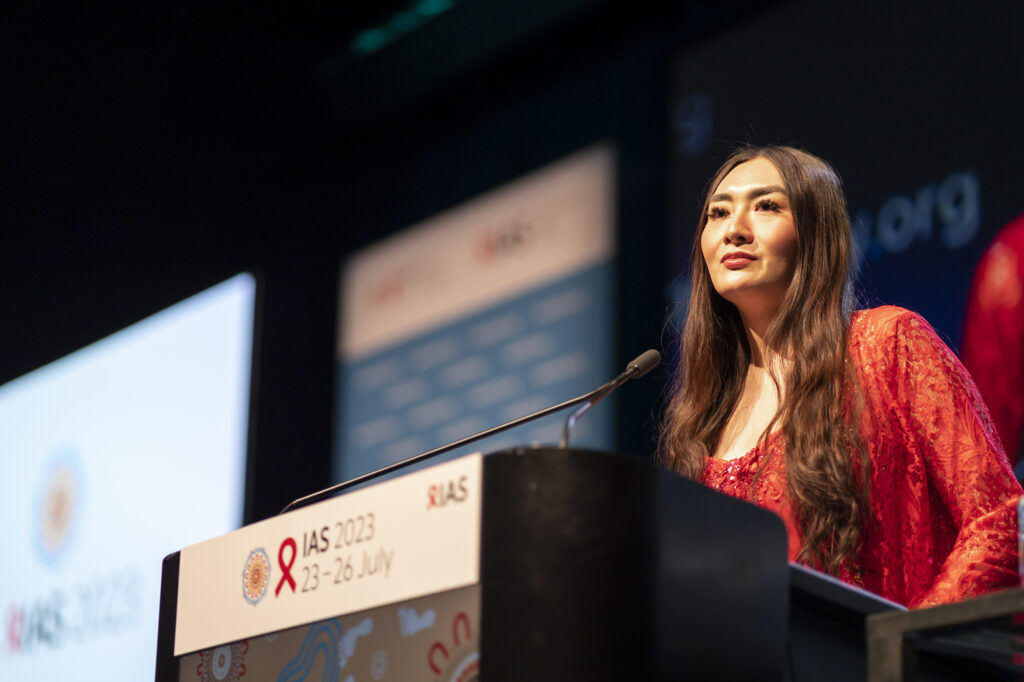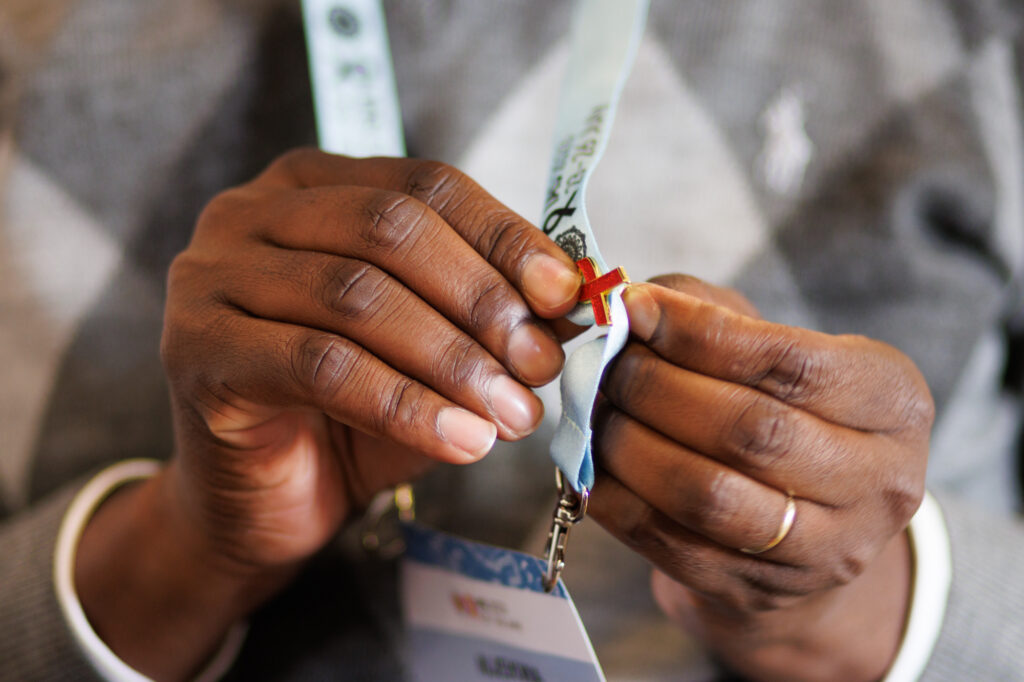
Dr. Alegra Wolter addresses the auditoriam during IAS 2023’s opening session. Credit: Conor Ashleigh/IAS
During the opening session of the 12th IAS Conference on HIV Science (IAS 2023) on Sunday, July 23, World Health Organization (WHO) director-general Dr. Tedros Adhanom Ghebreyesus applauded African countries, including Zimbabwe, Rwanda, Botswana, Eswatini, and Tanzania for achieving the 95-95-95 targets set to end the HIV pandemic by 2030.
He also recognized conference host Australia, which is closer than ever to eliminating HIV transmission in the country.
“Australia’s success tells us we have the science, the tools, and the know-how to stop infections and save lives. The challenge we all face now is replicating that success around the world,” said Dr. Tedros.
The comments underlined the inherent tension at any research conference, where experts face the task of linking the science presented to impact in the lives of people.
Before the opening session was over, that tension would be brought up several more times, most passionately by Dr. Alegra Wolter, Indonesia’s first openly trans physician.
“[We are] still struggling to bridge the gaps between scientific advancements, medical interventions, and leading experts with the communities that need them the most,” said Dr. Wolter when she took the stage.
Over the next four days, plenty of science was on display. Highlights included research around HIV prevention, treatment, and even cures that promise to have a very real effect on people living with HIV.
But there remain notable gaps, not just in bridging the science, as Dr. Wolter indicated, but in reaching the most vulnerable, including children, only 59 percent of whom even know their status globally.

Attendees flock to the exhibition space at IAS 2023. Credit Max Mason-Hubers / IAS
Children continue to be left behind in the global HIV response
There are a staggering 130,000 new infections in children each year. About 30 percent of these children still die from opportunistic infections, like tuberculosis or pneumonia, diarrhea, and malnutrition.
Even as we now have the tools we need to end pediatric AIDS, it remains a neglected disease, as Sr. Director of CHAI’s HIV program, Carolyn Amole, shared on the first day of the conference.
“We finally have optimal drugs like dolutegravir (DTG) for kids, but there is so much work left to be done. I worry about donors pulling back from the pediatric HIV space,” she said in opening remarks at a satellite session, which highlighted key learnings from Unitaid’s HIV treatment optimization portfolio.
During the session, Dr. Eleanor Namusoke-Magongo, a senior program officer for pediatrics and adolescent HIV care and treatment at Uganda’s Ministry of Health AIDS Control Program, shared the strides her country made after quickly adopting pediatric DTG into their national guidelines and introducing the drug to clients. By June 2022, the drug had led to 89 percent viral load suppression among children—that much closer to the 95 percent target.
Unitaid’s investments in Uganda were critical to driving the success of this program. Strong, cross-cutting partnerships—as well as funding—will be critical to replicating Uganda’s story across the African continent and beyond.

Accelerating access to injectable PrEP
Much like at last year’s AIDS conference in Montreal, long-acting injectable options to prevent HIV was the most discussed topic—both in and out of sessions—at IAS 2023.
While oral PrEP is highly effective when taken as directed, impact has been limited because many at risk of HIV struggle with adherence, pill burden, and stigma, among other factors.
Injectable PrEP removes many of these barriers and community advocates have expressed a strong preference for an injectable option. Long-acting injectable cabotegravir (CAB-LA) was approved by the United States Food and Drug Administration (US FDA) in 2021. Yet, over 18 months later, access in low- and middle-income countries remains extremely limited.
With the six-monthly injectable lenacapavir (LEN) currently under investigation in phase 3 clinical trials, there is an urgent need to learn from the delays in CAB-LA so that LEN doesn’t experience the same bottlenecks.
Ahead of the conference, CHAI published a roadmap to support the equitable introduction of affordable, generic CAB-LA, as well as other drugs in the pipeline. Proven partnership-driven models exist, such as with pediatric DTG. The vision is achievable, now it’s time to act.
More highlights from IAS 2023
- HIV self-testing is poised to expand given the new US$1 benchmark price. There are opportunities to learn from early adopters on how to apply self-testing in different cases, monitor and link self-testing to national care systems, and leverage digital solutions to improve linkage to care. Learnings from the global rollout and scale-up can also serve as a model for other disease areas.
- Over 20 pieces of CHAI-led research at the conference highlight many of the themes above, such as lessons learned on packages of care for adults and children living with advanced HIV disease.
- Integrating HIV programs with other health services to fight co-morbidities continues to drive discussion at the biggest AIDS conference in the world. Mpox and COVID-19 dominated, including learnings from the QuickStart Consortium on integrating COVID-19 test & treat programs into HIV care in Zambia. Abstracts on cervical cancer, hypertension, and hepatitis C also highlighted possible ways forward.
- WHO endorses U=U, or undetectable equals untransmittable. For the first time, the WHO stated in very clear language that people living with HIV have zero risk of transmitting HIV if they adhere to prescribed treatment.
- More hope for an HIV cure, and other breaking science from the conference are available in the HIV Unmuted podcast, produced by International AIDS Society.





